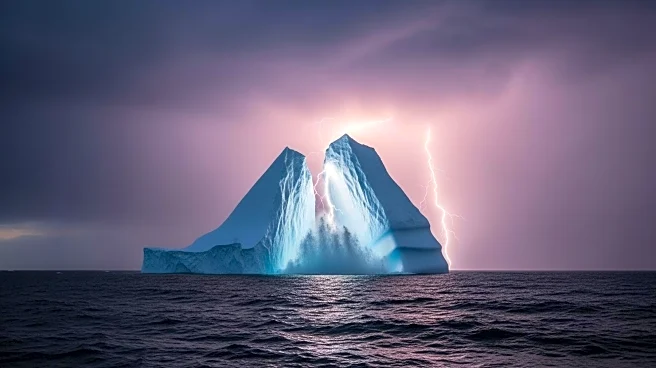What is the story about?
What's Happening?
The world's largest iceberg, known as A23a, is rapidly disintegrating as it drifts northward. Originally weighing about a trillion tons and covering an area nearly the size of Anchorage, Alaska, the iceberg has lost more than half its size in recent months. Massive chunks of ice, some measuring up to 250 square miles, have broken off, posing a threat to maritime navigation. The iceberg's total area has now reduced to 683 square miles. Andrew Meijers, a physical oceanographer from the British Antarctic Survey, noted that A23a is 'breaking up fairly dramatically' due to warmer waters. The iceberg's journey began in 1986 when it broke off from Antarctica's Filchner Ice Shelf. It remained grounded in the Weddell Sea for over 30 years before starting its northward drift in 2020.
Why It's Important?
The rapid disintegration of A23a highlights the impact of rising global temperatures on polar ice masses. While melting icebergs do not directly contribute to sea level rise, their disappearance signals broader climate change effects, such as accelerated glacial melt, which can raise sea levels. The iceberg's journey and current state serve as a stark reminder of the ongoing changes in the polar regions, which could have significant implications for global sea levels and climate patterns. The situation underscores the urgency of addressing climate change to mitigate its impacts on the environment and human societies.
What's Next?
As A23a continues to break apart, it is expected to become unidentifiable within weeks. The iceberg's disintegration will continue to be monitored, as it could provide valuable insights into the processes driving ice melt and climate change. The scientific community and policymakers may use this data to inform strategies for climate adaptation and mitigation. Additionally, maritime authorities will need to remain vigilant to ensure the safety of shipping routes affected by the iceberg's remnants.
Beyond the Headlines
The disintegration of A23a also raises questions about the long-term impacts of climate change on polar ecosystems. The iceberg's journey has already sparked concerns about potential disruptions to wildlife, such as penguins and seals, in the regions it passes. Understanding these ecological impacts will be crucial for developing conservation strategies in the face of a changing climate.
AI Generated Content
Do you find this article useful?
















